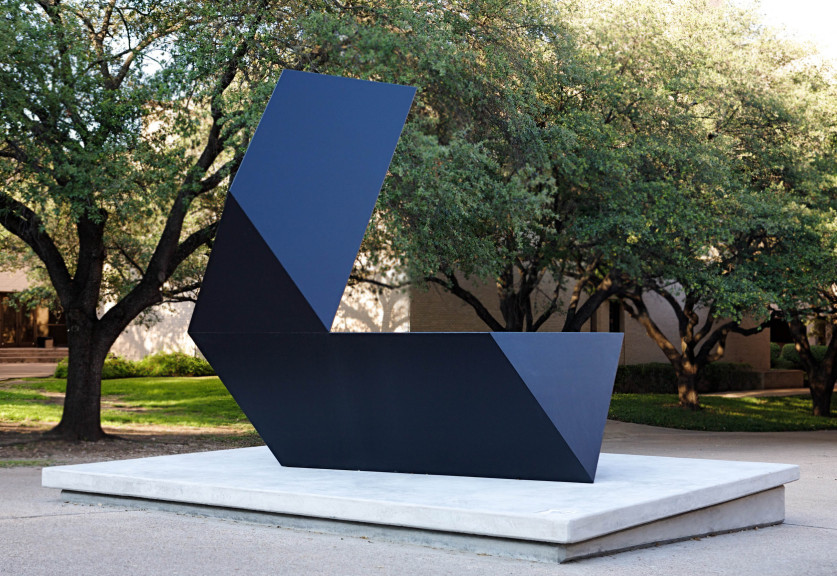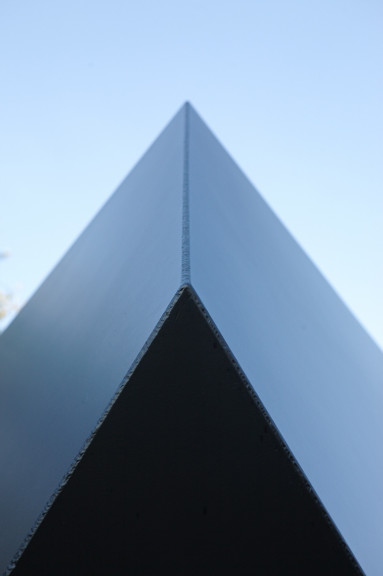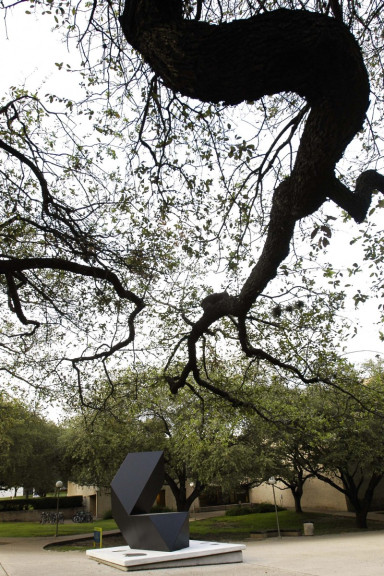Amaryllis
Tony Smith
135 × 128 × 90 inches
Photography not permitted
Lent by The Metropolitan Museum of Art, Anonymous Gift, 1986
1986.432ab
GPS: 30.286942,-97.731779
A polymath with interests as diverse as mathematical biology and modernist architecture, Tony Smith worked as a mechanical draftsman for his family’s municipal waterworks company while studying at the Art Students League in New York City. He trained as an architect in the 1930s and worked for Frank Lloyd Wright (1867–1959), whose use of mass-produced, modular homes inspired Smith to open his own architecture firm a few years later.
After moving to New York City, Smith became close friends with Jackson Pollock (1912–1956) and the Abstract Expressionist painters, subsequently designing a home for painter Theodoros Stamos (1922–1997) and exhibition spaces for a number of New York art galleries. During a two-year sojourn to Europe in the mid-1950s, Smith embarked on an ambitious series of abstract paintings, bringing his skills as a draftsman to the linear geometry of his compositions.
Ten years later, at age fifty, Smith began working in the medium for which he is best known: large-scale steel sculpture. The monumental scale and immersive quality of Smith’s sculpture was undoubtedly influenced by his architectural background. Indeed, Amaryllis began as an attempt to realize his vision of a “cave of light”—an open sculptural volume that would immerse and envelop the viewer. He worked with large sheets of plywood, combining multifaceted geometric elements like the cube and rhomboid arranged in linear configurations, which were later executed in steel by industrial fabricators. As curator Robert Storr observed, the sculpture “is based on compound articulations of two triangulated modules, the tetrahedron and the octahedron.”
Though the reductive form and monochrome black surface of Amaryllis call to mind the aesthetic of Minimalist art, Smith’s use of complex geometry contrasts with the simple mathematical progressions and elementary forms of Minimalist artists Sol LeWitt (1928–2007) and Robert Morris (1931–2018). The twisting angles of Amaryllis create a complicated, multivalent mass that changes dramatically as one moves around the work — shifting from flattened to dimensional, or from balanced to asymmetrical.
ACTIVITY GUIDES

Amaryllis
Tony Smith
Subject: Scale
Activity: Make a small-scale model
Materials: cardboard, scissors, tape or glue
Vocabulary: artist, model, scale, sculpture, shape, steel
Remind your child that everything we see has a size. Even among the same types of things, some can be larger or smaller. For instance, a toy car is a small version of a real car that an adult drives. If the toy car looks exactly like the larger one, except for its size, then we say it is a scale model.
This artist worked by making small cardboard shapes and arranging them in different orders to make a model. He would then have a larger sculpture made out of steel that looked exactly the same, only bigger.
What size is this sculpture? Is it large or small?
What size do you think was the artist’s model?
Can you see shapes in the sculpture? Which ones?
How do you think they are put together?
Examine the size of the sculpture and ask the child to think of things that are the same size. Note that this sculpture uses elemental shapes, like triangles and rectangles, in unusual ways.
Using the cardboard, make three-dimensional shapes for your child to use. They may be cubes, pyramids, spheres, etc. Ask the child to assemble them in ways that make new shapes and tape them together. Take the model outside and encourage the child to imagine a large- scale version. How big would it be (as big as a car or house?), and where would you put it?
Artist - someone who makes things, such as paintings and sculptures
Model - a small version of a large thing Scale - to change the size of something from smaller to larger or larger to smaller
Sculpture - a work of art that has height, width, and depth
Shape - an outline of a body, like a circle or square *Steel* - a strong metal used in buildings

Amaryllis
Tony Smith
Subject: Geometric Abstraction
Activity: Making 3D shapes in 2D
Materials: Construction paper, glue or tape, scissors, and pencil
Vocabulary: 2D, 3D, geometric, Geometric Abstraction, Minimalism
Tony Smith worked as an architect with Frank Lloyd Wright before becoming a sculptor in his forties. Working in the style of Geometric Abstraction and Minimalism, Smith believed that beauty could be found in simple geometric shapes. As you can see in this sculpture, using simple shapes, Smith made a form that is quite complex. As you walk around the sculpture, notice how different it looks from each side. Viewing the work from different angles makes some shapes prominent and others less apparent. Artists working in a Minimalist style strove to remove any evidence of the artist’s hand from their work. One way they tried to achieve this is through the industrial manufacture of their works. Smith made small cardboard models of his works, and then had a factory fabricate them in steel. The works were then painted matte black.
How does the matte black color of this sculpture impact how we see all of its shapes? Does it help or hinder?
Amaryllis is a kind of lily. Do you think this sculpture is representative of a flower?
Do you find the shapes and form of this sculpture to be beautiful?
On colored construction paper, draw a variety of geometric shapes in different sizes. When you have drawn fifteen or more, use scissors to cut out all of your shapes. On another sheet of white paper, experiment with arranging the shapes together. See if you can combine your 2D, flat shapes to make more complex forms that appear to be three-dimensional. Using tape or glue, arrange your 2D and 3D shapes to make a dynamic composition.
2D —Having two dimensions or sides (length and width)
3D—Having three dimensions or sides (length, width, and height)
Geometric —Using simple shapes and elements such as lines, circles, squares, and triangles
Geometric Abstraction —A style of art that uses geometric shapes to create a composition that is not representational or realistic
Minimalism —A style of art that strips down work to its most fundamental features, such as geometric shapes

Amaryllis
Tony Smith
Subject: Shapes
Activity: Making 3D shapes
Materials: Cardboard, pencil, scissors, and tape
Vocabulary: 3D, form, geometric, sculpture
Tony Smith worked as an architect before he became a sculptor. He believed that simple geometric shapes could be very expressive. This sculpture is made of simple geometric shapes that the artist combined to make a complex form. As you walk in a circle around the sculpture, see how different geometric shapes become noticeable on each side.
What shapes can you identify in the sculpture?
How would this sculpture be different if it were brightly colored instead of all black?
What does this sculpture remind you of? The artist titled the work Amaryllis after a flower.
On light cardboard, like that from a cereal box, draw a variety of geometric shapes in different sizes. When you have approximately ten different triangles, circles, squares, rectangles, and polygons in different sizes, cut them out from the cardboard. Using tape, experiment with attaching the shapes together in different ways until you make a 3D form. Can you make familiar shapes, like a pyramid? See if you can make a multisided form like the sculpture.
3D —Having three dimensions or sides (length, width, and height)
Form —The shape of something, as opposed to its surface
Geometric —Using simple shapes and elements such as lines, circles, squares, and triangles
Model —A small version of a large thing
Pentagon —A shape with five sides
Polygon —Any shape made of connected lines, such as a triangle, square, or pentagon
Sculpture —A work of art that has height, width, and depth
MORE INFORMATION
Born in South Orange, New Jersey (an affluent suburb of New York City), Tony Smith had to interrupt his college education in the early 1930s to help with the family toolmaking business as the Great Depression worsened. From 1934 to 1936, he studied drawing and painting at the Art Students League, followed by a year at the American Bauhaus School in Chicago, where he learned about European modern architecture and design. In 1939 he began working for the renowned architect Frank Lloyd Wright; Wright’s new plans for designing modular houses for mass production inspired Smith to head in that direction during the 1940s.
In New York during the 1950s, partly to offset his frustrations as an architect, Smith made abstract paintings of flat curved forms tightly grouped in a gridlike pattern. In 1956, at the age of forty-four, he started sculpting. But it was only in 1961, as he recuperated from a serious car crash, that he began to make small cardboard models of geometric sculptures. Smith used the cube, rhomboid, and tetrahedron as basic “building blocks,” which he arranged as modules in a linear configuration. From 1962 until his death in 1980, he developed this method, using large sheets of plywood. Smith passed these prototypes to industrial fabricators (such as Lippincott Company) to produce the final version in sheet metal painted black. After his death, his family decided to have the remaining models also fabricated.
Amaryllis, 1965
With Amaryllis and similar works, Smith helped define the style of geometric abstraction known as minimalism, an intellectually rigorous, reductivist approach that revived the prewar tradition of geometric abstraction (which by then had become somewhat rote and decorative). Minimalism was to some extent also a natural reaction against the unconstrained gesturalism of abstract expressionism.
Although considered one of the principal theorists and practitioners of minimalist aesthetics, Smith achieved a vitality often lacking in the works of others. Amaryllis demonstrates his ability to combine basic modules into an asymmetrical linear arrangement that activates the space it inhabits. As a viewer walks around Amaryllis, different configurations emerge and disappear. From some vantage points, the sculpture’s blocky three-dimensionality can appear flattened or neutralized. The triangular end panel of the horizontal form can appear to glow in sunlight while the side disintegrates into darkness. The horizontal element can appear to merge with the diamond-shaped bottom of the vertical form. From another angle, the horizontal element almost disappears. The pristine black surface enhances these optical illusions.
Valerie Fletcher is Senior Curator at the Hirshhorn Museum in Washington, DC. Her research on groundbreaking aspects of international, globalized, and transnational art have resulted in numerous exhibitions and publications.
Baro, Gene. “Tony Smith: Toward Speculation in Pure Form.” Art International 11 (Summer 1967): 27–30.
Burton, Scott. “Old Master at the New Frontier.” Art News 65 (December 1966): 52–55, 68–70.
Lippard, Lucy R. Tony Smith. New York: Abrams, 1972.
Lippard, Lucy R. “Tony Smith: Talk About Sculpture.” [interview] Art News 70 (April 1971): 48–49, 68, 71–72.
Senie, Harriet F. “Re-approaching Tony Smith.” Sculpture 17 (November 1998): 38–43.
Smith, Tony. Not an object. Not a monument. The Complete Large-Scale Sculpture of Tony Smith. Göttingen: Steidl; and New York: Matthew Marks Gallery, 2007.
Storr, Robert. Tony Smith: Architect, Painter, Sculptor. New York: Museum of Modern Art, 1998. Texts by John Keenen and Joan Pachner.
University of Maryland Art Gallery. Tony Smith: Painting and Sculpture. College Park, MD, 1974. Text by Eleanor Green.
The Metropolitan Museum of Art in New York generously loaned twenty-eight modern and contemporary sculptures to Landmarks for display throughout the Austin campus. The collection represents a broad array of artists working in the second half of the twentieth century. The initial sculptures were installed throughout the main campus in September 2008, and a second, smaller group were unveiled at the renovated Bass Concert Hall in January 2009.
Funding for the loan was provided by the Office of the President. This project was the result of a collaborative effort among many, including:
Leadership
Andrée Bober and Landmarks
Pat Clubb and University Operations
Douglas Dempster and the College of Fine Arts
Landmarks Advisory Committee
William Powers and the Office of the President
David Rea and the Office of Campus Planning
Bill Throop and Project Management and Construction Services
Gary Tinterow and the Metropolitan Museum of Art
Samuel Wilson and the Faculty Building Advisory Committee
Project Team
Chuck Agro, transportation, Metropolitan Museum of Art
Andrée Bober, curator and director, Landmarks
Caitlin Corrigan, registrar, Metropolitan Museum of Art
Cynthia Iavarone, collections manager, Metropolitan Museum of Art
Cliff Koeninger, architect
Ricardo Puemape, Project Management and Construction Services
Kendra Roth, conservator, Metropolitan Museum of Art
Patrick Sheehy, installation services
Nicole Vlado, project manager, Landmarks
Special Thanks
Valerie Fletcher, curatorial contributor
Beth Palazzolo, administrative coordination, University Operations
Russell Pinkston, composer
What’s Past Is Prologue: Inaugurating Landmarks with the Metropolitan Sculptures
With the arrival of twenty-eight modern sculptures on long-term loan from New York’s Metropolitan Museum of Art, the Landmarks program has begun. Their installation throughout the Austin campus offers a remarkable opportunity to survey some of the major trends in art during the second half of the twentieth century. These sculptures allow us to witness the distinctly modern dialogue between representation and abstraction, as well as the contest between natural and industrial materials. Most of all, we can celebrate their presence as an unprecedented chance to experience works of art first-hand––to appreciate their forms and to understand the underlying ideas.
The Landmarks program perpetuates in Austin one of civilization’s oldest and most enduring traditions: the placing of art in public areas, accessible to nearly everyone and expressive of collectively held ideas. More than five thousand years ago, the cultures of Egypt and Mesopotamia produced sculptures for urban plazas, government buildings, and places of worship to express political, secular, and religious values. Grand monuments endorsed the ruling elite and commemorated military victories, while images of deities symbolized spiritual beliefs. The original purposes of public art were primarily ideological and didactic, but what has endured through the ages is the physical beauty of the art. In modern times the contexts and goals for public art have changed considerably. In many parts of the world democracy and egalitarianism have supplanted absolute rulers, and explicit religious power has yielded to secular humanism. During the mid-to-late twentieth century (the era when the Metropolitan’s sculptures were created), globalization has redefined the entire world. Societies in Europe and the Americas have became so diverse that cultural authorities can no longer be sure of which systems of meaning and which values, let alone which individuals, should be honored in the traditional ways of public art.
A schism has developed between traditionalists and modernists. In a rapidly changing world those who wanted to preserve the familiar in art have continued to commission representational statues. Modernists, on the other hand, have embraced change and gladly jettisoned the old ways in favor of abstraction. The schism is exemplified by two famous memorials in Washington, D.C., both intended to commemorate the heroic sacrifices of American armed forces. The Marine Corps Memorial (1954) consists of a superbly realistic representation of soldiers struggling to raise the American flag on Iwo Jima in 1945. In contrast, the Vietnam Memorial (1982) consists of a massive V-shaped wedge of polished black stone inscribed with What’s Past Is Prologue: Inaugurating Landmarks with the Metropolitan Sculptures July 2008 the names of the dead. At the time it was inaugurated, this monument shocked nearly everyone outside the art world and outraged many of those it intended to commemorate. In response, a group of bronze figures of soldiers was added. But soon, precisely because of its universal form and absence of imagery, the original memorial became a powerful place where all Americans could go to grieve, remember, and pay homage. To most of the art world, this demonstrated beyond a doubt the viability of abstract sculpture for public places.
With America’s increasing wealth and social consciousness in the 1960s many towns began to institute programs of commissioning sculptures for public places. By requiring that 1 or 2 percent of each building’s construction budget be used for art, urban planners sought to improve the living and working environment for millions of people. The main difficulty was agreeing on what kind of art was visually pleasing and, just as important, potentially meaningful to the general public. Two highly publicized examples were the huge, abstract, metal sculptures by Pablo Picasso and Alexander Calder, in Chicago and Grand Rapids respectively, which at first provoked derision but gradually became a source of community identity and pride.
One way to approach works of art is to consider the historical context in which they were created. During the first half of the twentieth century, life and art underwent radical transformations. Industrial manufacturing supplanted agriculture as the dominant mode of production, people migrated from rural areas to urban centers, women and minorities gained equal rights, warfare expanded to an unprecedented global scale, and technology accelerated the pace of life—and art changed in tandem.
Abstraction
Early in the modern era, many artists believed that a new visual language was needed to replace the Greco-Roman classical figurative traditions that had persisted through two millennia. Photography had made mimesis (accurate depiction of reality) unnecessary in painting and sculpture for the first time in history. Artists were free to conceive radically new approaches, and so abstraction was born, emerging from 1910 to 1920 in Europe. Initially artists simplified and stylized observed reality into organic and angular forms. That first phase soon evolved into making “pure” abstractions with no recognizable sources. From the outset, abstract art carried implicit meanings recognized by artists and informed viewers but largely lost on the general public.
Early abstractionists intended their art to convey their commitment to an ongoing transformation of society. Like Morse code in telegraphy and other new modes of communication fundamentally different from the traditional written word, abstract forms in art could convey meanings—not narrative or literal ones but broad ideas that could speak to an international audience and help advance human consciousness.
During the 1920s and 1930s, artists developed two broad types of abstraction: geometric and biomorphic. Geometry denotes mathematics and suggests such related disciplines as architecture, design, engineering, and logic as well as intangible qualities like analytical thinking and precision—desirable attributes for a rational, communal society. Artists devised a new language of geometry in art: horizontal and vertical elements can convey calm, harmony, and stability (see Harmonious Triad by Beverly Pepper), while rising diagonals can suggest energy and optimism (see Column of Peace by Antoine Pevsner and Square Tilt by Joel Perlman).
In contrast to geometric abstraction, a number of artists favored softer forms and curving contours. Inspired by sources in nature, biomorphic abstractions evoke natural phenomena, biological processes, growth, and ambiguity (see Big Indian Mountain by Raoul Hague, Source by Hans Hokanson, and Untitled [Seven Mountains] by Ursula von Rydingsvard). Such works stand in general opposition to the industrial and technological aspects of modern life; they remind us of the fundamental importance of the natural world. Biomorphism was invented and advocated by the surrealists, who believed in the importance of the unconscious mind in creating and understanding modern art. Relying on the Freudian concept of free association, such artists expect viewers to generate their own unique responses to abstract art.
The two types of abstraction began as competing and opposing philosophies, but by the 1950s many artists expertly combined them to suit their expressive needs (see the rhythmic contours of Veduggio Glimpse by Anthony Caro and the disconcerting, hulking forms of Catacombs and Guardian by Seymour Lipton).
By the 1960s, the original philosophical meanings underlying abstraction had mostly faded away, leaving “formalist” aesthetics: the creation and appreciation of pure nonreferential beauty. Formalism dominated much artistic practice from the 1950s through the 1970s, particularly in the United States in the circle around the critic Clement Greenberg. Geometric sculptures became ubiquitous in public places—some complex and sophisticated and some merely competent. A group known as the minimalists advocated an intellectually rigorous, austerely reductivist approach (see Amaryllis by Tony Smith). Other artists went in the opposite direction, toward complexity and a decorative verve (see Kingfish by Peter Reginato). From those extremes emerged the postminimalists, who infused organic vitality into simple, singular forms (see Curve and Shadow No. 2 by Juan Hamilton).
Figuration
Despite the enthusiasm for abstraction in midcentury, a number of artists insisted on maintaining recognizable human content in their works. Abstraction had alienated many viewers who found it remote or incomprehensible. Yet few artists returned to traditional realism, preferring instead to explore new and evocative modes of representation.
The strongest resurgence occurred in the aftermath of World War II. Many artists, especially in Europe, wanted to pay homage to the sufferings experienced by so many people during the war and to their struggles to rebuild their lives and societies amidst the new fears engendered by the nuclear age and the Cold War. This atmosphere of postwar existential anxiety was poignantly expressed in two museum exhibitions in the 1950s: models for a never-realized Monument to the Unknown Political Prisoner at London’s Tate Gallery in 1953 and the avowedly humanist theme of the New Images of Man installation at New York’s Museum of Modern Art in 1959.
Many postwar sculptors expressed their angst by portraying figures or fragments of bodies as falling, broken, injured, or partially robotic (see Augustus by Bernard Meadows and Figure by Eduardo Paolozzi). Some erudite artists reinterpreted classical myths, particularly those in which a hero challenged the gods and were punished: Icarus, Hephaestus, Prometheus, Sisyphus (see works by Koren der Harootian and Frederick Kiesler). Seymour Lipton created a particularly effective amalgam of figure references within abstract forms that harbor dark inner spaces (see Pioneer, Catacombs, and Guardian).
Representational sculpture was submerged by the tidal wave of abstraction in the 1960s and 1970s, but a new generation insisted on a legible humanist content in art, addressing issues of personal identity and isolation in an impersonal world (see Eyes by Louise Bourgeois and Figure on a Trunk by Magdalena Abakanowicz).
Materials and Methods
Modern sculptors also introduced a new language of materials and methods. In the late nineteenth century, sculpture making had entered a new phase of mass production made possible through technology: bronzes could be produced in large editions by skilled technicians from an artist’s original. The Thinker by Auguste Rodin, for example, was made in several editions, ranging from a dozen life-size bronzes to hundreds of smaller casts. This mechanization and concomitant commodification of art prompted a reaction. Appearing simultaneously in several countries, the “direct carve” movement advocated older craft-based methods and sought to enhance the intrinsic characteristics of natural materials: the color and grain of exotic woods or the veining and crystalline structure of unusual stones. By the 1920s, this aesthetic had gained international prominence, and it persists to this day.
The first generation of direct carvers admired prehistoric, African, Oceanic, and indigenous American artifacts. By adapting the hieratic frontality and stylized forms of those sources to the sleekly refined forms of abstraction, modern sculptors could represent simplified figures linked in sophisticated linear rhythms (see works by Koren der Harootian and Anita Weschler). Recent artists of this orientation tend to work on a larger scale and may roughly cut and hew wood to achieve expressionistic textures (see works by Hans Hokanson and Ursula von Rydingsvard).
Carvers remained a relatively small minority in modern sculpture, far outnumbered by “direct metal” sculptors. Their approach emerged in prewar Europe and burgeoned into an international movement in the 1950s and 1960s. Seeking materials and methods appropriate to the modern Machine Age, artists looked to engineering and construction for inspiration. Instead of using chisels to carve wood and stone, constructivists preferred welding torches to cut and join pieces of metal. Their structures ranged from elegant abstractions to assemblages of cast-off objects.
The industrial analogy and model extended to the sculptors’ own studios, which resembled factory spaces with heavy-duty equipment. Some—like Anthony Caro, Willard Boepple, and Robert Murray—found inspiration in working spontaneously and experimentally with sheet metal: cutting, folding, rolling, welding, soldering, and sometimes painting or burnishing it. Other sculptors, notably Tony Smith, were comfortable with sending models to factories for professional fabrication. Both methods were considered appropriate for a modern world that had been so fundamentally reshaped by industrial manufacture.
In contrast, many sculptors preferred to make assemblages from miscellaneous bits and pieces of scrap, sometimes irreverently called “junk sculpture.” Although artists had experimented with this approach as early as the 1910s, it became a widespread tendency only decades later in the 1950s and 1960s, when sculptors made three-dimensional collages from the detritus of industrial manufacture and mass consumption: rusty machinery, old car parts, squished used paint tubes, broken musical instruments, virtually anything. The motivations for using trash range from simple necessity (when an artist has no money to buy new materials) to antimaterialistic social criticism and environmentalism (sculptors started recycling long before the idea occurred to others).
Regardless of the motivations, a found-object sculpture possesses an inherent dual identity: its former reality as a useful thing and its new reality as art. That dualism inevitably poses an intellectual and visual conundrum for us. Do we see Deborah Butterfield’s Vermillion primarily as a lifelike depiction of a horse or as a composition of rusty, crumpled bits of metal thrown out by a wasteful consumerist society? And what are we to understand from Donald Lipski’s seemingly abstract The West, which consists of decontextualized harbor buoys and lots of corroded pennies? The artists offer clues and hope that we will use our own eyes, intellect, intuition, and imagination to make connections and create meanings.
Landmarks: Sculptures for Inquiring Minds
Unlike works in private collections or even museums, public sculptures exist in our daily environment, interact with our activities, and enter our awareness repeatedly and variously. Beyond the pleasure they bring to viewers already acquainted with art, they can stimulate curiosity and spark new perceptions in the minds of passersby who might otherwise not have much aesthetic experience. As the university’s population seeks knowledge in classes, libraries, and laboratories, the Landmark sculptures can offer other kinds of discoveries. Visitors to the Perry Castañeda-Library, the Nano Science Technology Building, the School of Law, and elsewhere on the campus can now see immediately that the visual arts have a prominent place and come away enriched. Very few campuses or cities can boast so many sculptures of such quality that are free and accessible to all. The twenty-eight sculptures from the Metropolitan Museum of Art proclaim the broad purpose of the Landmarks program: to bring an important new dimension to the life of the university, to the everyday experience of its students, faculty and staff, the citizens of Austin and beyond, and to any person who just crosses the campus.
Valerie Fletcher is Senior Curator at the Hirshhorn Museum in Washington, D.C. Her research on groundbreaking aspects of international, globalized, and transnational art have resulted in numerous exhibitions and publications.



